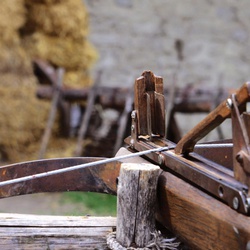Life in the castle: The weapons of attack and defence
Valle del Serchio. Più vicino a te

The walls of castles would be ineffective if they were not guarded and defended by men armed to the teeth. The walls were manned by sentries who marched along the parapet, ready to sound the alarm in case of necessity.
The first line of defence of the castle was passive: fences, walls, piling, ditches and battlements impeded the advance of the enemy, allowing the castle defenders to arm themselves. Four-pointed spikes called “triboli” or ‘thorns’, which pierced the feet of troops and the hooves of horses, causing pain and terrible infections that led to death, since they were first steeped in manure.
It is easy to build up a picture of the military equipment from the inventories of the fortifications. The most common weapons were those that made it possible to strike from a distance, such as long bows and crossbows with huge bolts. The latter, although the range was less than the long bows, could count on the parabolic shot, which made them more dangerous. They were made in many different sizes, such as the “manesca”, which could be held in one hand, the "treppiede” or tripod-mounted crossbow and the devastating “baliste” capable of firing real javelins.
Ingenious machines were devised to break the line of defence: catapults and trebuchets hurled stones over long distances, covered battling rams crashed through gates, mobile bridges forged ditches and wooden towers on wheels tackled the walls.
Once over the walls, hand-to-hand fighting ensued with swords, knives, daggers, axes, mallets and flails, lances and hooks. The only protection came from the armour, made of hides, leather or metal, and shields. The type of armour varied depending on the requirements of cavalry and infantry and could be “light”, with less armour-plating and more flexible to allow movement, or "heavy".
Much changed with the discovery of gun powder: muskets appeared on the walls, able to fire fast and deadly lead balls, and the towers were furnished with artillery, such as bombards, later full cannons of large calibres. The weapons of attack also changed and muskets, small cannons, falconets, culverin and full-sized cannons were widely used, adapting heavy bombards so they could be transported on military campaigns.
Military treatises of the sixteenth and seventeenth centuries are replete with images of special projectiles designed to cause disarray among the enemy ranks: hollow spheres filled with pieces of metal were the forerunners of grenades and huge spheres were filled with explosives, to be detonated with a thunderous explosion in the middle of the enemy soldiers. The indomitable and combative spirit of the people of Grafagnana was reflected in the blazing sphere, the heraldic emblem chosen by the Duke d’Este to symbolise the Province of Garfagnana.



